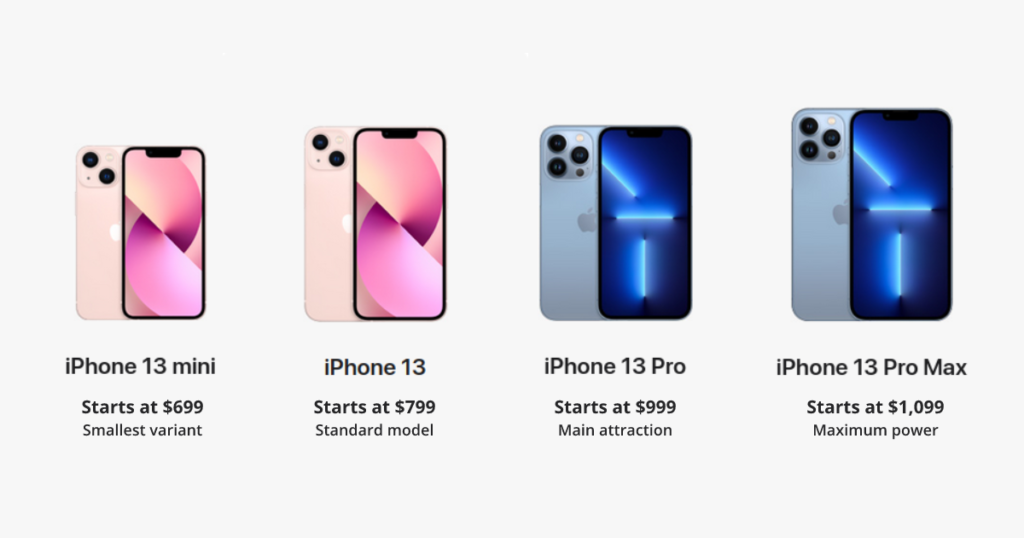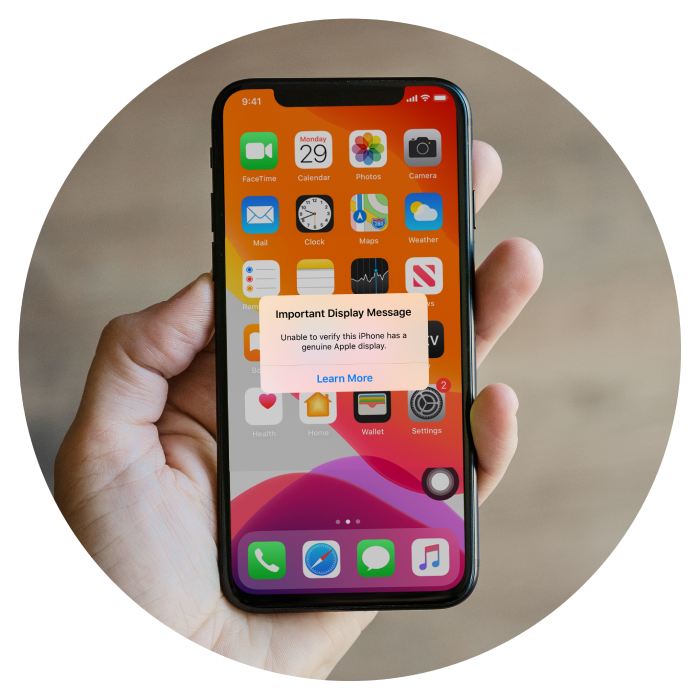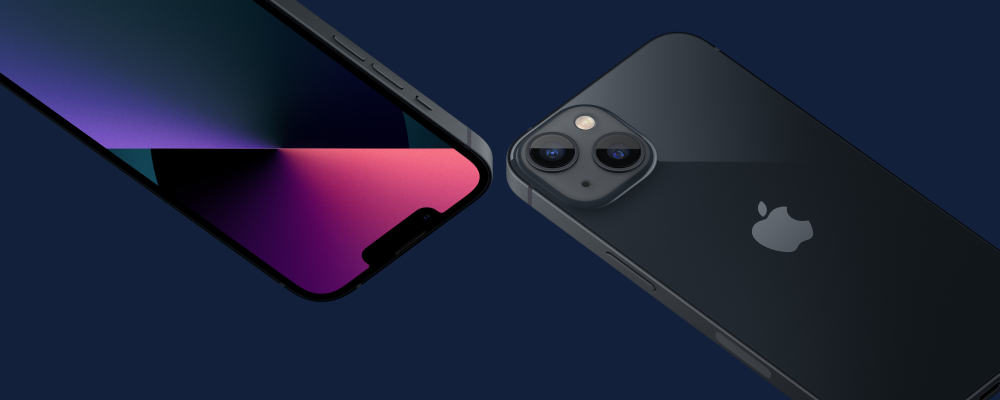The new iPhone 13 line has just hit the market and customers are already lining up to catch a taste of it. Apple touts this as a faster, more durable, and more appealing iPhone than last year’s offering. And while the changes may seem hardly noticeable at first glance, the iPhone 13 line might surprise (and infuriate) you with what it has to offer. Let’s dive into what the iPhone 13 is all about, and what it means for repair shops in the future.
Meet the family
iPhone 13 carries over the same trend from last year – it’s got 4 different versions for sale:
- The iPhone 13 mini,
- iPhone 13,
- iPhone 13 Pro, and
- the iPhone 13 Pro Max.
Spreading the iPhone 13 line over 4 variants gives it the advantage of covering a range of price points and use cases. For general or basic use, the iPhone 13 or 13 mini serves the purpose well. If you want the absolute best and have the cash to spare for it, the iPhone 13 Pro and Pro Max are the ones for you.
Apple’s strategy to split its main offering into 4 different models makes sense if you look at it like this. Each phone has its reasons for being there and offers something the other models lack.

What’s new on the board?
This year, there are a couple of differences between the different iPhone models on sale.
iPhone 13 and 13 mini
First off, we have the standard iPhone 13. This is Apple’s standard phone starting at US$799. It sports a 6.1-inch Super Retina XDR OLED screen with the company’s patented ceramic glass coating on top. The phone sports the A15 Bionic chipset, and comes in either 256GB or 512GB configurations. Both variants have 4GB of onboard memory.
It’s got a dual-camera array on the back that has both wide and ultrawide lenses. The cameras also have the same stabilization technology as the iPhone 12 Pro models from last year, which is an upgrade over their previous versions.
While the company continues to use the outmoded Lightning charging port, the battery inside is a 3,240 mAh pack that supports fast charging at 20W. It should be noted, however, that those speeds are only achievable from the Lightning-to-USB-C cable and charger, sold separately. As with last year, MagSafe and Qi wireless charging are also included.
As with last year’s model, there’s also the iPhone 13 mini, the younger sibling of the standard model. According to GSM Arena, this variant sports a smaller screen size of 5.4 inches, and a smaller battery at 2,438 mAh. While the smaller power pack means the phone won’t be an endurance champ, the smaller screen actually benefits it with more pixels-per-inch and lighter weight. Thanks to these differences, the iPhone 13 mini is easier to pocket and handle, making it ideal for young adults or people who prefer smaller phones. Other than the smaller frame, though, the iPhone 13 mini packs almost every feature that the regular iPhone 13 possesses.
iPhone 13 Pro and Pro Max
Apple tradition for almost half a decade has been to release a bigger, more powerful version of its standard iPhone alongside the main offering, and this year is no different. The iPhone 13 Pro and Pro Max are the top-of-the-line devices for this year, and they’ve got a few differences to make them stand out.
For starters, the phone is now encased on the sides with a stainless steel finish that adds a lot of polish to the look and feel of the phone. It weighs a bit more as a result, but with a phone that has “Pro” in the name, that’s to be expected. The added heft feels right in the hands without going overboard.
One of the advantages of the larger frame is having more battery life packed into it. The iPhone 13 Pro houses a 3,095 mAh battery, with the Pro Max bumping it up to 4,352 mAh. That’s considerably more power that should help with endurance, aided further by the A15 Bionic’s energy efficiency and 5nm build.
The added size also adds more acreage to the display. While the iPhone 13 Pro sports the same 6.1-inch display as the standard phone, the Pro Max takes it up to 6.7 inches. Also setting the phone apart from other models is the first-ever 120Hz refresh rate display in iPhone history. The new refresh rate makes the phone feel faster and more fluid, even if it’s pretty late to that party.
The biggest reason for people to invest in the Pro models is for the camera system. The three-camera setup here adds a telephoto lens to the mix and ups the aperture size. This unique array of cameras gives the iPhone 13 Pro series a distinct sales edge.
Unlucky Number 13
The iPhone 13 series is yet another incremental upgrade for phone users when all is said and done. However, for repair shops, it’s a whole other game entirely. The iPhone 13 yet again brings with it not just annoyances, but actual headaches when it comes to repairs.
Let’s start off with trying to get into the phone. The iPhone 13 uses multiple different types of screws to keep everything together. This also includes security screws that can be a real pain. Switching between at least 4 different types of screwdriver heads is not a good start and it only gets worse from there.
The hardware has been slightly modified to make repairs more cumbersome for third parties. Firstly, there’s a new battery design that makes it incompatible with previous versions. This means the iPhone 13 battery will need to be specially ordered. Also changed is the new connecting cable of the display. The new display, while having a smaller notch, also unifies the picture and touch cables into a singular one. This can complicate repairs, as anything that causes damage to the touch inputs could also knock your display out entirely.
The biggest problem, however, is the software security that comes with repairing the new iPhone. Apple had implemented software security measures to discourage repairs in the iPhone 12, and it seems they’ve taken it a step further with this new iteration.

Limiting by design
The software security on the iPhone 13 heavily discourages third-party repairs. It forces you to either go through Apple’s repair framework or lose out on some important features with their new phones. This effort underpins any sort of repair shop software‘s effort to carry out a successful iPhone repair.
For starters, any repairs require you to power on the device with a Lightning cable before it can be used. This is a provision that Apple added to the iPhone 12 as well, and it’s just as annoying here. Without connecting the Lightning cable to a charging source, your iPhone 13 will not power on after a repair has been done.
Face ID
The new display and camera system has internal software that prevents proper use in case of repairs. When you replace either the display, the camera, the sensor cable, or the logic board, the phone will display a bunch of warnings when powered on. Depending on the repair, you will then be locked out of Face ID and will be unable to use it. This creates a major security issue if you choose to repair your iPhone either by yourself or from a third party.
Face ID cannot be activated if you’ve changed your display, changed your camera, or changed the sensor cable connecting the camera to the display. The feature simply will not work and will display an error message.
Screen replacement issues
Additionally, replacing the screen also disables auto-brightness, meaning your phone cannot automatically adjust itself anymore. In addition, you’ll find the Battery Health and True Tone options removed from within the settings of the phone. They will not appear and you cannot restore them even with a system reset. This effectively cripples some of the more convenient features of the iPhone 13 that people will hate.
The auto-brightness feature is a common occurrence in almost any smartphone and disabling it is highly contentious. This sort of action shows the anti-consumer nature that Apple is pushing with its policies. While Battery Health and True Tone can be argued as being of lesser importance, disabling a feature as common as auto-brightness takes it way too far.
Camera replacement issues
The troubles don’t end there. For the front-facing camera, replacing it will also cripple your phone’s camera software. You will be unable to take pictures in Portrait Mode or the new Cinematic Mode at all. When using Portrait Mode, the shutter button refuses to take a picture and the different effects do not work. For Cinematic Mode, pressing the shutter button starts a recording with a perpetually stuck timer, and no video is saved. Additionally, the front camera viewfinder begins to lag and refreshes once every few seconds showing only a single image.
To say that the front-side camera is hamstrung here would be an understatement. Apple’s approach seems extremely cruel, making the front camera near useless following a repair. With the Apple camera software itself is now locking up because of repairs, the company has proven that it will go to any lengths to stamp out third-party fixups.
What a wicked game to play
With the release of the iPhone 13 lineup, it’s clear what Apple wants. Controlling their devices on such a level means it’s firmly against the idea of losing out revenue on any front. Apple’s hardline stance against USB-C in iPhones coupled with these new measures put them at firm odds with the repair industry. With this act, the company clearly shows that they’re willing to go to extreme measures to fight against the right to repair.
Were it not for the software component pairing, the iPhone 13 could have been a great phone for repairs. It’s got a modular design and taking it apart isn’t too difficult. However, Apple’s insistence on controlling every repair means this iPhone is going to be another painstaking device to repair.

